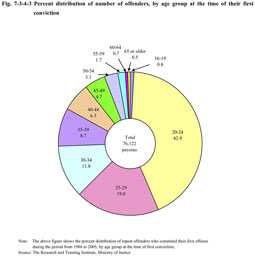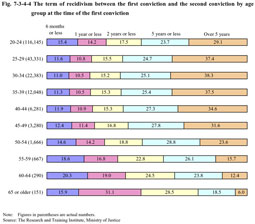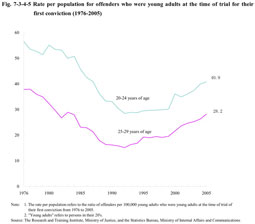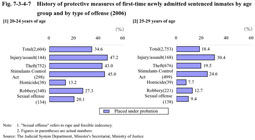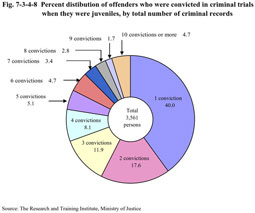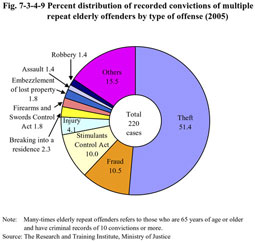| Previous Next Index Image Index Year Selection | |
|
|
2 Age
(1) General overview
An important part of our research on repeat offenders involved an examination of their age groups and characteristics. Particularly focused upon with regard to age group were: 1) “Young Adults” convicted in their twenties, 2) “Teenagers” convicted between the ages of 16 and19, and 3) “Elderly Persons” convicted at the age of 65 years and over. Table 7-3-4-3 shows the percent distribution of offenders by age group at the time of the first conviction, with the offenders being convicted of the first offense during the 25 years from 1980 to 2005, in the 500,000 Repeat Offenders' Recorded Convictions. More than 40% received their first conviction in their early twenties (20-24 years old). Combining this with those who received their first conviction in their late twenties (25 - 29 years old), it accounts for more than 60% of the total. Fig. 7-3-4-3 Percent distribution of number of offenders, by age group at the time of their first conviction Fig. 7-3-4-4 shows the term of recidivism from the first conviction to the second conviction by age group at the first conviction, using the 700,000 Non-Repeat and Repeat Offenders' Recorded Convictions. 47% of people in their early twenties, more than 50% of those 55 years old and over, and about 75% of the elderly persons were convicted for a second offense within two years.Fig. 7-3-4-4 The term of recidivism between the first conviction and the second conviction by age group at the time of the first conviction (2) Young Adults Fig. 7-3-4-5 shows the change in the ratio of offenders who were young adults at the time of trial for their first conviction per 100,000 young adults over the last 30 years. The number of persons in their twenties has been declining since 1997. Conversely, the ratio of offenders who were young adults at the time of trial for their first conviction was the lowest for the last 30 years in 1992, but has continued to almost constantly rise since then. In 2005, the ratio of those in their early twenties and those in their late twenties returned to the levels of 1987 and 1984, respectively. Fig. 7-3-4-5 Rate per population for offenders who were young adults at the time of trial for their first conviction (1976-2005) Fig. 7-3-4-6 gives the follow-up analysis of recidivism by age group of the first conviction based upon the 700,000 Non-Repeat and Repeat Offenders' Recorded Convictions.41.0% of those who committed their first offense in their early twenties (20-24 years old) and about 28.2% of those who committed their first offense in their late twenties (25-29 years old) subsequently committed repeat offenses and, compared with other age groups, the rate of recidivism was high. A tendency of recidivism by those who committed their first offense in their early twenties was seen to be particularly strong, which is also revealed by the Five Year Recidivism Rate of those who committed their first offense in their early twenties being approximately 25%, which is considerably higher than that of those in any other age group (refer to Fig. 7-3-3-4). Fig. 7-3-4-6 Percent distribution of number of offenders, by age group at the time of their first conviction and by presence or absence of their repeat offense Fig. 7-3-4-7 shows the history of protective measures of first time admitted offenders by age group and type of offense. The rate of early twenties inmates who have a history of protective measures is significantly higher than offenders in their late twenties, disregarding the type of offense.In particular, with those sentenced to prison due to injury, assault, theft or violations of the Stimulants Control Act, which are the major offenses given in Fig. 7-3-1-1, the rate of those with a history of protective measures is high. This tendency was discovered also to be the same every year from 1996 to 2005 (Source: Annual Report of Statistics on Correction), suggesting that many of those who committed their first offenses in their early twenties were delinquents from juveniles. In addition, regarding those in their late twenties or older, the rate of those with a probation history falls remarkably, and decreases as they age. Based upon this analysis, the characteristics of young adult repeat offenders could be summarized as follows. 1) Young adults, particularly those who committed their first offense in their early twenties have a high rate of recidivism with the term of recidivism also being short when compared with those in other age groups who committed their first offense in their age group. (For an analysis of those convicted while juveniles, refer to the next subparagraph (3) in this section). 2) Many young adults who were imprisoned in their early twenties had already received protective measures while juveniles. This rate is especially high when the crime resulting in imprisonment was injury, assault, theft, or violations of the Stimulants Control Act. Recidivism prevention measures, therefore, need to be strengthened for those who commit their first offenses in their early twenties. Regarding the timing of intervention and treatment, the focus needs to be on the first two years when the possibility of committing repeat offenses arises after the offender is released from prison for their first offense. Fig. 7-3-4-7 History of protective measures of first-time newly admitted sentenced inmates by age group and by type of offense (2006) (3) Juveniles The repeat-offense situation with juveniles convicted in criminal trials will now be examined. Fig. 7-3-4-8 gives the percentages of 3,561 offenders (29 sixteen-year-olds (0.8%), 231 seventeen-year-olds (6.5%), 776 eighteen-year-olds (21.8%), and 2,525 nineteen-year-olds (70.9%)) that while juveniles were convicted during the period of 1965 until the base date by total number of criminal records. Fig. 7-3-4-8 Percent distibution of offenders who were convicted in criminal trials when they were juveniles, by total number of criminal records About 60% of juveniles convicted in criminal courts then committed repeat offenses, considerably higher than the percentage (about 30%) of adult first-time offenders committing repeat offenses. Upon examining the percentage of juveniles convicted in criminal trials that then committed repeat offenses by offense, theft accounted for 81.1%, and Stimulants Control Act violations 76.6%, both markedly high proportions.Furthermore, using as an example to study the tendency of those convicted in criminal trials while juveniles to commit delinquent acts, of those whose final decisions in family courts were reference to public prosecutors, over the recent period of the five years from 2002 to 2006, 72.9% to 75.1% had probation histories (excluding negligence in the pursuit of social activities in traffic accidents and dangerous driving causing death or injury), which is a very high percentage (Source: Annual Report of Judicial Statistics). As seen above the percentage of offenders committing repeat offenses after having been convicted in criminal trials while juveniles is considerable. Judging by the fact that most juvenile criminal cases ended up in juvenile protection cases at family courts, it is conceivable that most of those convicted in criminal trials while still juveniles had been involved in delinquent behavior before and had not been rehabilitated, even with the help of probationary guidance, or they had considerably advanced criminal or delinquent tendencies with their previous acts having been malicious or serious. This then points out the need for stronger more careful repeat offense prevention measures to be taken. (4) Elderly Persons Fig. 7-3-4-4, which shows the term of recidivism from the first conviction to the second conviction by age group at the first conviction, reveals that, regarding the term of recidivism of elderly offenders, especially the ratio of those who committed a repeat offense within six months to one year is remarkably high in comparison with other age groups. When combined with those who committed repeat offenses within six months, about half of them committed repeat offenses within one year. Also, Fig. 7-3-3-5, which shows the trends in recidivism rate of multiple repeat offenders by age group using the 500,000 Repeat Offenders' Recorded Convictions, reveals that the rate of elderly multiple repeat offenders has grown rapidly, accounting for 20.3% in 2005, which when combined with the rate of those from 55 years to 64 years of age reaches 64.4%. Clarifying the type of offenses multiple elderly repeat offenders committed, Fig. 7-3-4-9 shows the distribution of the number of convictions by offense of multiple elderly repeat offenders who had ten or more recorded convictions as of 2005. Theft accounted for 51.4%, more than half, and when combined with fraud, which was next in number of cases, property offenses accounted for about 62%. Also, violations of the Stimulants Control Act accounted for 10%, indicating that a considerable number of offenders are unable to stop abusing drugs despite their advanced age. Based on these facts, we believe that recidivism prevention measures for elderly offenders need to correspond with the very short term period before re-offending, and the need to concentrate on intervention over that short period. Special attention also needs to be paid to preventing property offenses, such as theft and fraud, committed by many multiple elderly repeat offenders, by considering the background of the offenders and by also providing special treatment for elderly drug abusers. Fig. 7-3-4-9 Percent distribution of recorded convictions of multiple repeat elderly offenders by type of offense (2005) |
